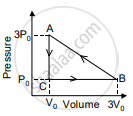Advertisements
Advertisements
प्रश्न
Explain the thermodynamics of the isochoric process.
उत्तर
- A thermodynamic process in which the volume of the system is kept constant is called the isochoric process.
- A system does no work in its environment during an isochoric process.
- For an isochoric process, ΔV = 0, and from the first law of thermodynamics, ΔU = Q.
- The temperature of the system changes, i.e., ΔT ≠ 0.
- This means that for an isochoric change, all the energy added in the form of heat remains in the system itself and causes an increase in its internal energy. Also, as volume is unchanged, no work is done.
- The first law of thermodynamics for the isochoric process is, Q = ΔU ….(1)
The change in internal energy is given by,
ΔU = nCVΔT ….(2)
The work done is given by,
W = pΔV = 0 ….(∵ ΔV = 0)
From equations (1) and (2),
The heat exchanged is given by,
Q = ΔU = nCVΔT - p-V diagram of isochoric process is as shown below:

संबंधित प्रश्न
An ideal gas is taken through an isothermal process. If it does 2000 J of work on its environment, how much heat is added to it?
For work done to be reversible, the process should be ______
What is a thermodynamic process?
Draw a p-V diagram showing positive work at constant pressure.
Differentiate between the reversible and irreversible processes.
Explain graphically (i) positive work with varying pressure, (ii) negative work with varying pressure, and (iii) positive work at constant pressure.
Explain the thermodynamics of the isobaric process.
When a cycle tyre suddenly bursts, the air inside the tyre expands. This process is ____________.
When you exercise in the morning, by considering your body as a thermodynamic system, which of the following is true?
The V-T diagram of an ideal gas which goes through a reversible cycle A→B→C→D is shown below. (Processes D→A and B→C are adiabatic)

The corresponding PV diagram for the process is (all figures are schematic)
In an isochoric process, we have ____________.
Give the equation of state for an isothermal process.
Give an expression for work done in an isothermal process.
Apply first law for an isobaric process.
Give the equation of state for an adiabatic process.
Draw the PV diagram for the isothermal process.
Draw the PV diagram for the adiabatic process.
Draw the PV diagram for the isobaric process.
Draw the PV diagram for the isochoric process.
A thermodynamic system undergoes cyclic process ABCDA as shown in the figure. The work done by the system is ______

An ideal gas is expanded isothermally from volume V1 to volume V2 and then compressed adiabatically to original volume V1. If the initial pressure is P1, the final pressure is P3 and net work done is W, then ____________.
An ideal gas is made to go from a state A to stale B in the given two different ways (see figure) (i) an isobaric and then an isochoric process and (ii) an isochoric and then an isobaric process. The work done by gas in the two processes are W1 and W2 respectively. Then,

One mole of an ideal gas with `gamma` = 1.4 is adiabatically compressed so that its temperature rises from 27° C to 47° C. The change in the internal energy of the gas is (R = 8.3 J/mol.K) ____________.
Two identical samples of a gas are allowed to expand (i) isothermally (ii) adiabatically. Work done is ____________.
Which of the following processes is reversible?
In the figure shown here, the work done in the process ACBA is ______.

